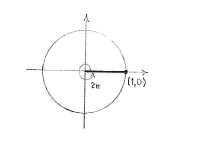Solution 4.2:3b
From Förberedande kurs i matematik 1
(Difference between revisions)
m (Lösning 4.2:3b moved to Solution 4.2:3b: Robot: moved page) |
|||
| Line 1: | Line 1: | ||
| - | {{ | + | The angle |
| - | < | + | <math>\text{2}\pi </math> |
| - | + | corresponds to a whole revolution and therefore we see that if we draw in a line with angle | |
| + | <math>\text{2}\pi </math> | ||
| + | relative to the positive | ||
| + | <math>x</math> | ||
| + | -axis, we will get the positive | ||
| + | <math>x</math> | ||
| + | -axis. | ||
| + | |||
[[Image:4_2_3_b.gif|center]] | [[Image:4_2_3_b.gif|center]] | ||
| + | |||
| + | Because | ||
| + | <math>\cos \text{2}\pi </math> | ||
| + | is the | ||
| + | <math>x</math> | ||
| + | -coordinate for the point of intersection between the line with angle | ||
| + | <math>\text{2}\pi </math> | ||
| + | and the unit circle, we can see directly that | ||
| + | <math>\cos \text{2}\pi =1</math>. | ||
Revision as of 11:51, 28 September 2008
The angle \displaystyle \text{2}\pi corresponds to a whole revolution and therefore we see that if we draw in a line with angle \displaystyle \text{2}\pi relative to the positive \displaystyle x -axis, we will get the positive \displaystyle x -axis.
Because \displaystyle \cos \text{2}\pi is the \displaystyle x -coordinate for the point of intersection between the line with angle \displaystyle \text{2}\pi and the unit circle, we can see directly that \displaystyle \cos \text{2}\pi =1.

